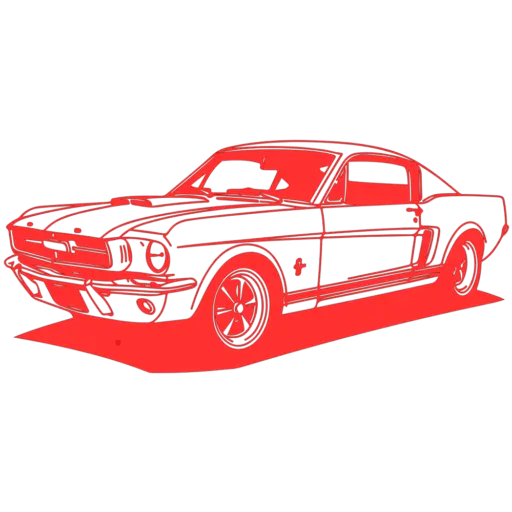Discover my personal experience with accident cases and how they were resolved Good classic car insurance can make all the difference. Real-life cases and effective solutions.
My first scare with the '67 Mustang
I'll never forget that Sunday afternoon. The sun was shining, and the back roads of the Mediterranean coast seemed to invite me to enjoy my newly restored '67 Ford Mustang. After three years of meticulous work, I could finally enjoy every curve in that beautiful red coupe.
What started out as a perfect day turned into a nightmare when a distracted tourist on his smartphone crossed the center line and slammed into my left front fender. The sound of twisting metal chilled me. My jewel, my baby, my passion project was damaged.
At that moment, I was grateful I had followed the advice of my uncle Miguel, a veteran collector, who insisted I hire a classic car insurance specialized policy, not a standard one. "The difference," he told me, "you won't notice until you need it."
And boy was he right.
Why conventional insurance doesn't work for classics
Before I share how my case and others like it were resolved, let me explain something fundamental I learned the hard way: conventional insurance and classic car insurance are completely different worlds.
In a modern vehicle, insurers calculate depreciation and, in the event of a total loss, pay you the current market value (always lower than the purchase price). But with a classic, the situation is reversed: its value usually increases over time if it's well maintained.
When my friend Carlos had an accident with his 1970 Mercedes 280SL Pagoda, his conventional insurance wanted to pay him just €15,000, when the real market value was over €80,000. His case confirmed to me that I had made the right decision.
+See more: Classic Car Insurance: Is It Worth Protecting Your Heirloom?
Real cases of classic car accidents and their resolutions
My case: The Mustang and the agreed valuation
After my Mustang accident, the process with my specialized insurance company was surprisingly smooth:
- I activated the specific support service for classics
- A specialized flatbed truck (not a conventional crane) picked up the vehicle
- The insurer offered me the choice between their specialized workshop or my trusted one.
- An expert specializing in classical restorations assessed the damage
Thanks to the agreed valuation of my policy (we had established a value of €45,000 for the vehicle), there were no discussions about depreciation or market value. The repair, which included the handcrafting of discontinued parts, amounted to almost €8,700, which the insurer fully covered.
The car was perfect, respecting its originality and using appropriate restoration processes. Not every garage knows how to work with 1960s sheet metal, and that specialized knowledge made all the difference.
Elena's Case: Ferrari Dino and the Garage Fire
My friend Elena lived a nightmare when a short circuit in her garage's electrical system caused a fire that partially destroyed her 1972 Ferrari Dino 246 GT, a vehicle valued at more than €300,000.
His classic car insurance not only covered the damages, but:
- He transported the vehicle to Italy, to a specialized Ferrari Classiche workshop.
- Covered the import of original parts from Ferrari's heritage department
- He financed the accommodation so that Elena could visit the workshop and supervise part of the process.
- Issued post-restoration certificates of authenticity that maintained the vehicle's value
The process took almost 9 months, but the result was amazing. If I had had a accident insurance conventional, they would probably have declared the car a total loss and Elena would have lost her family treasure.
Jorge's case: Multiple collision in a classic rally
During the 2019 Costa Brava Historic Rally, my colleague Jorge suffered a serious accident when another participant lost control on a curve and crashed into several vehicles, including his 1982 Porsche 911 SC.
The accident case reports Historic rallies are often complicated by the competitive nature of the event. However, his classic sports car insurance specifically covered participation in historic events (something many policies exclude).
The resolution included:
- Specialized expertise with knowledge of the model and its particularities
- Complete restoration supervised by Porsche Classic specialists
- Coverage for original parts, even the rarest and most expensive ones
- Compensation for the loss of value of the vehicle after restoration (a concept that conventional insurers do not even consider)
Key aspects that made the difference in these cases
Analyzing my experience and that of other collectors, I can identify crucial elements that determined a satisfactory resolution:
Agreed valuation vs. market value
The most important element of a good classic car insurance It's the agreed-upon appraisal. In my case and Elena's, having a predetermined and documented value avoided arguments about how much the vehicle was actually worth.
I recommend updating this appraisal every 18-24 months, as the classic car market can experience significant changes. My Mustang, for example, has increased its value by 28% since I first insured it.
Specialized workshops and original parts
Conventional insurers often refer claims to authorized workshops that lack experience with historic vehicles. accident case reports demonstrate that this results in inadequate repairs that can significantly depreciate the vehicle.
My insurer allowed me to choose a specialized workshop, which guaranteed that:
- Original construction methods will be respected
- Suitable parts (original or handcrafted) will be used.
- Maintain the patina and period look where appropriate
Critical additional services
Aspects that made the difference in our cases:
- Roadside assistance with specific platforms (not conventional cranes)
- Coverage during events and exhibitions
- Temporary storage during repair
- Compensation for post-repair depreciation
- Advice from restoration experts
Lessons learned and advice for other collectors
After my experience and analyzing numerous accident case reports, I share these recommendations:
- Thoroughly document your vehicle: Detailed photographs, professional appraisals, restoration and maintenance invoices. This was crucial when I needed to prove my Mustang's pre-accident condition.
- Review the policy exclusions: My friend Pedro discovered too late that his insurance did not cover travel to international exhibitions when he suffered an accident in France.
- Check coverage for additional drivers: When I lent my classic to my brother for his wedding, I made sure it was specifically covered.
- Ask about post-repair depreciation: Some premium policies compensate for the inevitable loss of value following a major accident.
- Consider coverage for parts undergoing restoration: If you restore it yourself, make sure the removed parts are also covered.
Tranquility is priceless
My Mustang accident could have been the end of my passion for classic cars. Instead, it became just another anecdote and a valuable lesson about the importance of a classic car insurance appropriate.
Today, five years later, my collection has grown, and each vehicle has its own specialized policy. The small additional cost compared to conventional insurance has been worth every penny when I've needed to use it.
If you own a classic car or are thinking of acquiring one, don't skimp on proper protection. As we often say in our club, "We are temporary custodians of these historic gems," and part of that responsibility includes properly protecting them for future generations.
Have you had any experience with classic car accidents? I'd love to hear your comments and expand this catalog of accident case reports that can help other fans.

He's been passionate about classic cars for as long as he can remember. His story began in his grandfather's garage, watching the painstaking restoration of a 1957 Chevrolet Bel Air. It was in that space, amid the smell of grease and the stories told, that he discovered his love for old four-wheelers.

